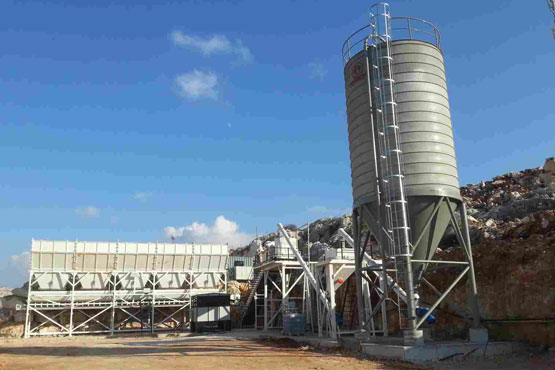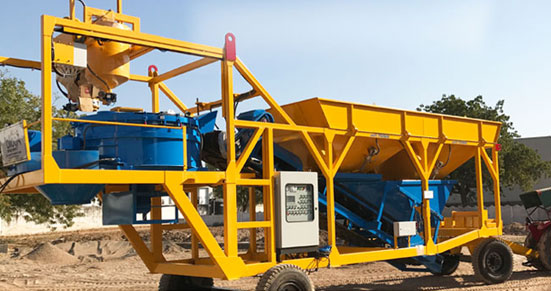Table of Contents
The concrete batching plant industry stands at the intersection of engineering excellence and logistical precision. As a fundamental part of the modern construction ecosystem, concrete batching plants are central to delivering the quality and volume of concrete required by large-scale infrastructure projects. Whether it’s a highway in a developing city or a high-rise tower in a booming metropolis, concrete batching equipment ensures timely, consistent concrete supply. But behind the scenes, the industry faces both expansive opportunities and stubborn constraints that impact its trajectory.
Let’s explore into this dual reality and unpack how the industry is growing while maneuvering through a labyrinth of challenges.
Testimonials
“India’s largest manufacturer of construction equipments. Quality equipments and quick service provider, top class management.”
What is a Concrete Batching Plant and Why It Matters?
At its core, a concrete batching plant is a facility used to produce concrete by combining various ingredients like water, cement, sand and aggregates. It ensures these elements are measured and mixed in the right proportions to create high-quality concrete. This plant may be stationary or mobile, manual or automatic, depending on the project needs.
Key Components of a Concrete Mixing Plant:
- Mixers: Twin shaft, planetary or drum types
- Weighing systems: For precision measurement of cement, water and aggregates
- Control systems: Manual to fully automatic controls
- Storage silos and bins: To store raw materials safely and efficiently
Concrete batching plants enhance productivity, reduce labor dependency and offer consistency in concrete quality – critical for construction performance. Their relevance continues to grow as urban construction demand rises globally.
Growth Catalysts in the Concrete Plant Manufacturing Sector
Despite facing various challenges, the industry is propelled by several strong growth drivers. The global expansion of cities, modernization of transportation infrastructure and increasing real estate development all contribute to rising demand for concrete batching solutions.
Opportunities Driving Growth:
- Urbanization: Expanding cities require massive volumes of concrete, making batching plants indispensable.
- Government infrastructure investments: Public sector projects demand timely delivery of ready mix concrete.
- Technological integration: The rise of automatic concrete batching plants streamlines operations and boosts output.
Manufacturers that incorporate automation, data analytics and smart systems into their concrete batching equipment find themselves better positioned in a competitive market.

The Rise of the Ready Mix Concrete Plant
Ready mix concrete plants simplify logistics by preparing concrete off-site and transporting it as needed. They reduce on-site mixing hassles, ensure consistent quality and save time – especially for urban projects with tight deadlines.
Why Concrete Plants are Gaining Popularity?
- Improved quality control: Batch quality is monitored in real time at the plant.
- Faster project execution: Eliminates mixing time on the construction site.
- Less waste and cleaner sites: Centralized production cuts down spillage and contamination.
As cities continue to densify, rmc plants are set to become even more prevalent due to their efficiency and environmental benefits.
Constraints and Challenges Limiting Expansion of Batching Plants
With growth comes resistance. The concrete plant industry must navigate several operational and strategic hurdles. These constraints can delay adoption or reduce efficiency if not addressed effectively.
Common Industry Challenges:
- High capital investment: Setting up a full-scale concrete batching plant can be capital-intensive, especially in regions with limited financing options.
- Regulatory hurdles: Land acquisition, zoning laws and environmental clearances may complicate setup.
- Raw material supply volatility: Cement and aggregate prices can fluctuate, affecting production costs.
- Inconsistent electricity supply: Particularly in developing nations, this can hamper plant operations.
These constraints necessitate adaptive strategies and leaner production models from manufacturers and project developers alike.
Operational Challenges Within Concrete Batching Facilities
Even once a plant is up and running, the day-to-day operations bring their own share of concerns. From technical malfunctions to human error, consistent management is critical.
Operational Pain Points:
- Maintenance downtime: Worn-out mixers or faulty sensors can halt production.
- Unskilled labor: Operating an automatic concrete batching plant requires technical training.
- Weather dependency: Heavy rain or extreme temperatures can affect concrete curing and batching accuracy.
To counteract these issues, many plant operators are investing in workforce training programs and more robust preventive maintenance systems.

Balancing Efficiency with Compliance
Concrete batching plants are also subject to safety and environmental regulations. Noise, dust emissions and spillages must be minimized and compliance failures can result in penalties or shutdowns.
Compliance Requirements:
- Dust control systems: Filters and covers on material bins
- Safety protocols: PPE, machinery guards and emergency stop systems
- Spill management: Proper drainage and storage of slurry and waste
Meeting these standards not only avoids legal complications but also improves the working environment and public perception.
Future Outlook for the Concrete Batching Plant Industry
The road ahead for the concrete batching plant industry is paved with both promise and pressure. As demand rises, particularly for high-volume and high-speed infrastructure projects, so too does the need for innovation and efficiency. Success in this sector will increasingly depend on how well businesses can navigate local regulations, adapt to new technologies and align with construction trends.
Manufacturers that can deliver cost-effective, flexible and smart batching solutions will thrive. Likewise, construction companies that leverage advanced concrete batching equipment can enhance their competitiveness by ensuring timely project completion and superior build quality.
Client Speaks
“We have purchased concrete plant & transit mixer from Apollo Inffratech and the working performance of machines are quite satisfactory.”
Conclusion
The concrete batching plant industry stands at a pivotal juncture. While opportunities abound in the form of expanding urban infrastructure, growing real estate sectors and technological innovation, constraints such as high capital costs, regulatory delays and operational inefficiencies persist. A successful path forward involves strategic adaptation – leveraging the benefits of automation, focusing on market-specific needs and ensuring operational excellence across the board.
Table of Contents


